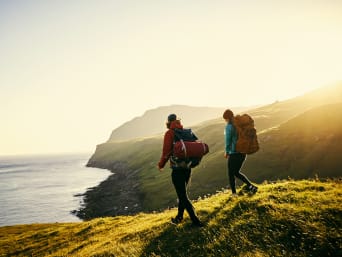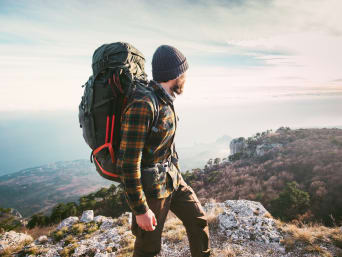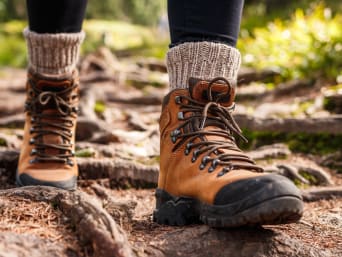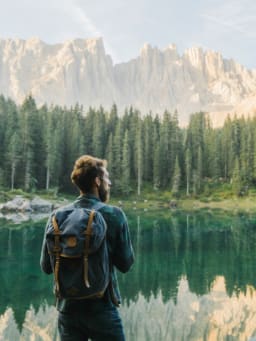Hiking gear: everything you will need for going on a hike
You will need to make sure you have packed everything you will need when going on a long hike. It’s not only important to make sure that you have high-quality hiking gear, but you also don’t want your backpack to be too heavy. Therefore, it is a good idea to only pack the things you really need to help save space and stop your backpack from becoming too heavy. In this article we'll show you which hiking essentials every beginner needs and also how to pack your backpack for going on a hike.
We have also put together a practical hiking kit list to help make sure you have everything you will need for your hike:
Hiking kit list
Important hiking essentials for beginners
It’s good idea to have a look at the area where you would like to go hiking so that you will be prepared and have everything you will need. Have a look at the different trails and see if anyone has left any comments or feedback about that hiking trail. This will give you a better idea of what weather conditions you can expect, where to stay overnight and whether you can buy food and drink along the way.
For beginners, a hut tour that regularly passes shops to restock supplies is recommended. You can save on special hiking accessories such as tents and cooking utensils and concentrate on your hike.
To avoid carrying too much on a multi-day hike, it is worth investing in lightweight, high-quality products. Such hiking gear is easy on your back and can also be reused for many years. On a longer hiking tour, the weight of your backpack is crucial. Every piece of equipment has a certain weight that you must carry around for days. It is advised to keep track of the total weight of your hiking gear before setting off. Write down the weight of each item - from the smallest sock to the sleeping bag. This way you know exactly how much your backpack will weigh at the end. A beginner's backpack should weigh around 10 kg in total. This isn’t too heavy and it makes hiking a lot easier, especially for beginners.
The ideal hiking backpack and packing tips
A hiking backpack is one of the most important pieces of hiking gear. Make sure that it fits your back and is of good quality so that it can carry the weight of all your hiking essentials. To find the right model for you, you can get advice in a specialist shop. You can try out different hiking backpacks with weights and have them adjusted to fit your back.
Below we have listed some tips on what your hiking back should have:
The main load should be on your hips to relieve your shoulders. A wide, padded pelvic strap is recommended.
Make sure your backpack is the right length so that the weight can rest on your hips.
To avoid sweating on your back, it is helpful if your hiking backpack is equipped with an appropriate ventilation system, such as mesh or padded ventilation. This prevents the backpack from resting directly on your back and causing you to sweat underneath.
It is handy if your hiking backpack has a rain cover so that you can simply put it over your backpack in bad weather.
For long-distance hiking beginners, a capacity of 30 litres is recommended for the first few hikes. If you want to take your hiking essentials such as a tent and cooking utensils, you should choose a hiking rucksack with a capacity of 50 litres.
How to pack your hiking backpack
There are a couple of things to keep in mind when it comes to packing your backpack before going on a hike. With the right packing technique, you can pack your backpack in a way that is easy on your back and you will also know where everything is:
Very light items such as your down jacket or sleeping bag should be at the bottom of your backpack
Pack heavy items as close to your back as possible
Clothes and other items that are not too heavy are best packed on the outer edge of the main part of your backpack
Make sure that your rain gear is on top. It will be handy in case of a sudden change of weather
Smaller items can be stored in the small side pockets
Important items such as your water bottle or hiking poles can be stowed in the side pockets of your rucksack
Stuff sacks hardly add any weight and can help keep your things organised
This way you distribute the weight well and ensure a perfect balance.
What to wear when going on a hike
Just like with other sports, for example, running and jogging you can follow the layering principle for hiking clothes. This means that you put on several thin layers that keep you warm and dry and you can easily take them off when needed. This allows you to adapt to different weather conditions.
To help you stay warm and dry even in cold and wet conditions, you should wear clothes in layers:
Base layer: this consists of a breathable functional shirt.
Insulation layer (mid-layer): a fleece or thin down jacket will keep you warm.
Weather protection layer (shell layer): this serves as protective layer against the wind and rain.
The example above will help to give you an idea of what you should pack for going on a long hike:
Comfortable underwear
Long-sleeved shirt
Hiking trousers
Hiking socks
Thin fleece jacket
Jumper (depending on where you are going to be hiking)
Down jacket
Raincoat & trousers
Especially for the base layer, shirts made of (merino) wool are recommended. These are absorbent, dry quickly and do not absorb odours as much. They are perfect for going on a long hike. However, you should make sure that the wool comes from a certified organic farm.
To prevent your clothes from getting wet whilst hiking, you can also pack them in plastic bags or dry bags. This will keep your clothes clean and dry, even if you get caught in a downpour. You can also use them for your wet clothes until you have a chance to let them dry.

Even in warmer regions, go for long-sleeved shirts and functional trousers, as these will protect you from the sun. Headgear should also be in your hiking rucksack at all times of the year to prevent sunburn.
How to find the perfect pair of walking boots
You will need a comfortable pair of walking boots, as you will be on your feet for most of the day. It is important that your walking boots fit you and your planned hike perfectly. As with your hiking rucksack, get advice from a specialist shop if necessary. There you can try on the shoes and test them.
The perfect walking boots offers you good support even on rough terrain and gives your ankles additional stability. This protects you from injuries and guarantees good surefootedness. Walking boots also have a waterproof or wax coating to protect your feet from moisture. Since the material used to protect against moisture wears off over time, you should regularly spray your walking boots with a waterproofing shoe spray.
Once you have found the right walking boots, you should first break them in thoroughly before going on a long hike. Try to wear your hiking boots as often as possible to get used to them and avoid blisters.
Hiking gear for long hikes
If you would like to go camping, you will need additional hiking gear. This includes a sturdy tent and possibly cooking utensils. To sleep comfortably at night without feeling cold, you will also need a sleeping mat and a suitable sleeping bag. Below we have listed some things you should keep in mind when buying hiking gear:
A good sleeping mat protects you from the cold and from the hard ground. Since the underside of the sleeping bag is compressed between the body and the ground, it cannot keep the heat optimally.
You need to make sure that you have the right sleeping bag depending on where you are going to be hiking. When hiking in Central Europe, we recommend sleeping bags that can keep you warm at night even in sub-zero temperatures. 3-season sleeping bags are suitable for temperatures from 0 to -10 °C. If you are hiking somewhere much colder, you will need a winter sleeping bag.
You can choose from many different tent models. Tunnel and dome tents are most used for walking holidays. Dome tents can be pitched on hard ground and do not need to be secured. Tunnel tents must always be secured, but they are lighter and more spacious than dome tents.
What should you take with you to eat on a long hike?
If you have decided to cater for yourself on your walking holiday, a diet rich in carbohydrates is the ideal choice. Since your body needs enough energy for each stage of your hike, it is important to always have enough food and drink with you. In addition, your food and drink should be as light as possible so that your backpack does not become even heavier.
Energy bars and dried fruit are ideal as a snack in between and give you a lot of energy
Freeze-dried meals are easy to carry and simple to prepare
If you want to cook for yourself, polenta and rice are very good staples
For breakfast, muesli packed in portions is a good choice
You can find more suggestions and even recipes for hiking online on many blogs and forums.
In addition to having enough food, you should also make sure that you always have enough drinking water on hand. Check beforehand whether there are enough drinking water sources on your hiking route or whether you will need to take extra bottles of water for certain sections. If you are going on a hike with no restocking options or places to stop to refill your water bottles with safe tap water, water purification tablets or a water filter will help you to have safe drinking water.

Always plan at least one extra meal in case of problems. This way you are on the safe side if you arrive at your destination later than planned.
Additional hiking accessories and must-haves for a long-distance hike
To make sure you don't forget anything, especially on long hikes, there are a few other useful items you can pack. Some of them are designed to keep you safe, others to make you a little more comfortable.
Use biodegradable soap. solid natural soaps made from vegetable oils are particularly good. However, you should still make sure that the residues from these types of soaps do not end up in rivers or lakes. Instead, you can stand on the side of the river and apply the soap and get some water and wash the soap off. You can replace travel laundry detergent with grated curd soap.
Choose plastic-free and environmentally friendly alternatives to toothbrushes and toothpaste. Bamboo toothbrushes or wooden toothbrushes are good options. For toothpaste, you can choose environmentally friendly natural cosmetics or toothpaste tablets.
Microfibre towels are light, very absorbent, and dry quickly afterwards.
A special outdoor or hiking umbrella will protect you from sudden changes of weather. These umbrellas are stable, light, and easy to carry with carabiners or belt loops.
A first aid kit with bandages and personal medication should be every hiking backpack. In a small first aid bag you can also store a signal whistle.
On longer hikes or due to delays, you may also be hiking at dusk or at night. To get a better idea of the terrain ahead, it is helpful to have a torch or headlamp with you.
A general recommendation when choosing hiking accessories is to look for products that are as sustainable and environmentally friendly as possible. Try to avoid plastic and opt for reusable hiking accessories, for example, refillable water bottles and metal lunch boxes. You should also pack a rubbish bag so that you can take dispose of your rubbish in the nearest bin.
Conclusion: everything you will need for your first hike
When it comes to choosing the right hiking gear, it’s best to choose practical and comfortable hiking essentials. You should also choose lightweight but sturdy items that are made of high quality materials so that you can use them time and time again. Before buying a hiking rucksack and the right walking boots, it is best to go to a specialist shop for advice. This way you can be sure that your hiking gear fits comfortably and is easy on your back and feet. With the right packing technique, you can also ensure that you can store all your hiking gear in a space-saving way.
______________________________________________
References and further information
https://www.caucasus-trekking.com/general/trekking-packing-list
(Last accessed on 23.04.2024)
https://www.beyoftravel.com/outdoors/hiking-packing-list-what-to-pack-for-a-hike/
(Last accessed on 23.04.2024)
https://getoutside.ordnancesurvey.co.uk/guides/what-to-wear-walking/
(Last accessed on 23.04.2024)
https://www.trespass.com/advice/how-to-pack-a-rucksack/
(Last accessed on 23.04.2024)
https://www.wellplannedjourney.com/day-hiking-essentials/
(Last accessed on 23.04.2024)
The image sources in this text are in chronological order
Cover photo: iStock.com/pixdeluxe
1. Image in text: iStock.com/Everste
2. Image in text: iStock.com/Zbynek Pospisil
3. Image in text: iStock.com/knape







